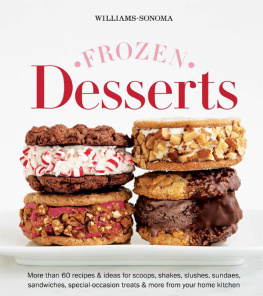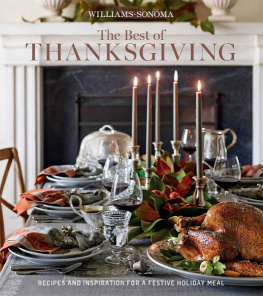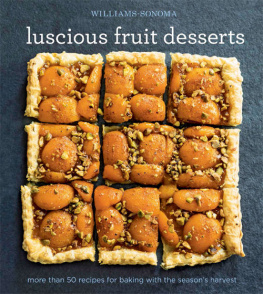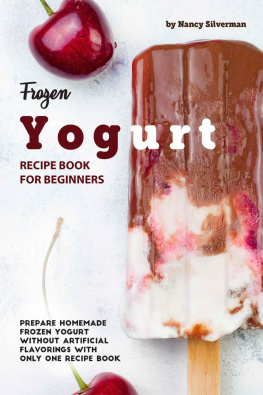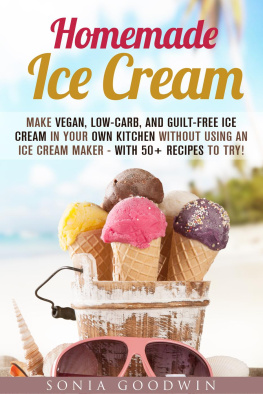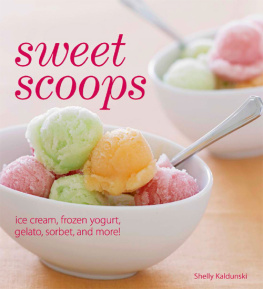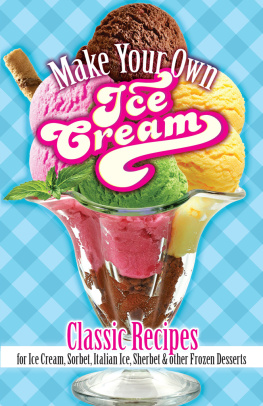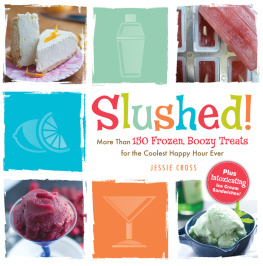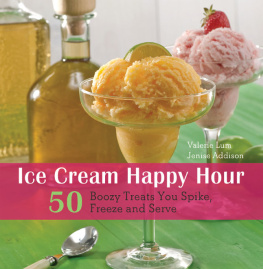Frozen Desserts
The Editors of
Williams-Sonoma
photographs by
John Lee

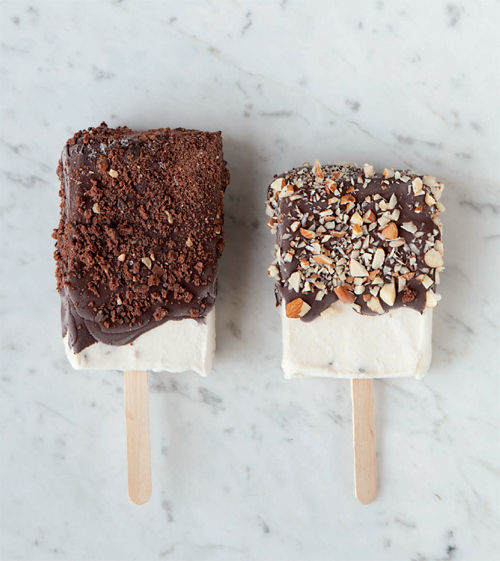
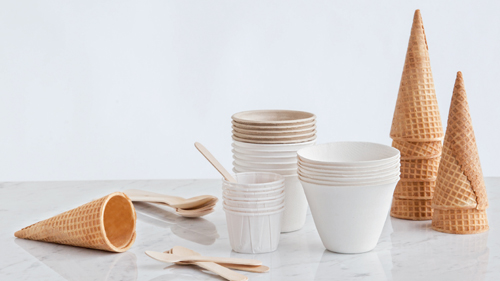
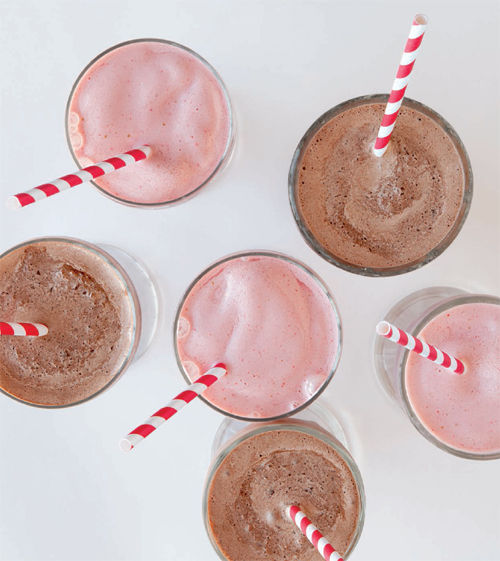
Icy Treats for Any Occasion
From a simple scoop of ice cream to an old-fashioned shake to an elegant multilayered tortefrozen desserts are both varied and versatile, with something to appeal to everyone. This book shows you how to make all of the elements at home (or how to layer in purchased ingredients for ease) for the ultimate icy treats.
The book begins with a chapter on the basics, including ice cream, gelato, frozen yogurt, sorbet, and granita, all made with an electric ice cream maker. Youll find all the classic flavors (vanilla, chocolate, caramel, and more) inside, plus a number of creative recipes, including sweet bay leaf, cereal milk, and bourbon ice creams; a frosty granita made from root beer; and a frozen yogurt flavored with rose water. The next chapter covers all the things you can make to accompany your frozen treats: gooey sauces, crisp cookies and cones, crunchy toppings, and more, to bring new layers of flavor and complexity to your creations. The third chapter builds on the first two by showing unique and creative ways to use elements of each chapter to create soda fountainstyle treats at home. Think shakes, malts, slushes, and sodas that will please any palate. A special feature on building a sundae bar offers inspired ideas for casual get-togethers. The final chapter reveals a wealth of ideas for more elaborateyet achievablecakes, tortes, pies, and bonbons using the recipes and ideas from the earlier chapters. Many, such as the elegant frozen cheesecake and the whimsical, sprinkle-covered ice cream cake, can be completely finished ahead of time and can hold in the freezer for up to a day before they are plated and presented at the table. A primer on making your own ice cream sandwiches offers easy ideas for handheld desserts.
Throughout the book, youll find tips for serving, storing, and personalizing frozen desserts. When possible, we offer suggestions for weaving in purchased ingredients to help streamline tasks on a busy schedule.

Types of Frozen Desserts
Crisp cones topped with slow-churned ice cream; paper cups overflowing with frosty granita; thick, old-fashioned shakes and malts; and crowd-pleasing ice cream cakes are universally loved. This book will show you how to make all these tempting treats and more, along with an array of gooey sauces, crisp toppings, and other delicious embellishments. All of the treats in this book start with the basicsice cream, gelato, frozen yogurt, sorbet, and granita, which can stand on their own or be layered with other elements to create more elaborate frozen desserts, such as those you might find at an old-fashioned soda fountain or at a sweet shop.
ICE CREAM The term ice cream is descriptive of its basic makeup: iced or frozen creamor milk and creamsweetened with sugar. Most of the recipes inside are French style, made from a cooked egg custard that must be chilled before churning. Two recipes are made without a custard base: a crunchy peanut butter ice cream as well as a coconut milkbased ice cream, which can be served to vegans.
GELATO Arguably the best loved of Italian desserts, gelato is made with less cream than French-style ice cream and, thus, has a higher ratio of egg to milk along with a dense texture and intense flavor. Because they are naturally rich, gelatos tend to be stand-alone desserts, needing no sauces or other adornments.
FROZEN YOGURT A softer, tangier version of ice cream, frozen yogurt is a popular treat. If you start with high-quality purchased yogurt, frozen yogurt is even easierand fasterto make than ice cream, because it doesnt require making, straining, cooling, and chilling a custard before churning. Be sure to choose yogurt that contains no gelatin or stabilizers.
SORBET Sorbet starts with a sweet juice or pured mixture that becomes light and fluffy while churning in the ice cream maker. It contains no eggs or dairy productsnothing to dilute the intense flavor of the main ingredient, which is usually fruit.
GRANITA Granita starts with a similar sweet, syrupy mixture to sorbet, but, instead of being frozen in an ice cream maker, the mixture is frozen in a pan and stirred or scraped by hand to produce a dessert with an icy consistency.
SODA FOUNTAINSTYLE TREATS Shakes, malts, parfaits, sundaes, and slushes are popular with kids and adults alike. The elements of many of these treats can be prepared ahead of time, and they generally require minimal last-minute preparation.
SWEET SHOP SPECIALTIES Ice cream cakes, sandwiches, and bonbons are impressive, and perhaps even easier to put together than their nonfrozen counterparts. The elements can be made ahead of time, and they can be assembled in advance.

Making Frozen Desserts
Good-tasting, well-textured ice cream relies on a well-made custard. This process may seem intimidating at first, but becomes second nature once you make it a few times.
PREPARING A CUSTARD BASE
Making custard-style ice cream calls for incorporating eggs into a hot milk-based mixture. You need to be careful during this step so that the eggs dont cook on contact with the hot mixture and turn the mixture lumpy. Below are tips for handling the three critical moments in creating a custard base: tempering, thickening, and cooling.
Tempering eggs Tempering refers to the process of gently raising the temperature of the eggs for even blending into a hot milk-based mixture. Begin the process by whisking the egg mixture as called for in your recipe. Keep whisking while slowly pouring in the hot milk mixture until its almost all incorporated. Then, slowly pour the resulting egg-milk mixture back into the saucepan and whisk constantly until blended. Place the saucepan back on the stove top and follow the directions in the recipe to complete the custard.
Thickening a custard Custard takes time to thicken, so dont try to rush it by turning up the heat. If the custard boils, it could curdle. To tell if a custard has thickened properly, run your finger along the custard coating the back of the stirring spoon. If it forms a path that remains for a few seconds before it begins to flow together, the custard is ready.
Cooling a custard over an ice bath For the smoothest results, a custard should be chilled completely before adding it to the ice cream maker. The first step is to rapidly cool down the custard over an ice bath after it finishes cooking. To make an ice bath, fill a large bowl halfway with ice cubes and enough water just to cover the ice cubes. Place the bowl with the custard into the larger bowl and let cool for 3045 minutes, stirring occasionally.
CHURNING FROZEN DESSERTS
Ice cream, gelato, frozen yogurt, and sorbet need to be churned in an electric ice cream maker. There are basically two types of ice cream makers available today. The first type features a double-walled canister with liquid coolant between the walls. The canister must be pre-frozen for up to 24 hours before you use it. When inserted into the ice cream makers casing, an electric motor turns a dasher that keeps the freezing mixture moving at all times to form the desired texture. The second type of ice cream maker is a self-contained model that features a small electric freezing unit surrounding a metal tub into which you pour the frozen dessert mixture. These types of machines do not need to be prechilled. Every ice cream maker is different. Before starting a recipe, be sure to read the instruction manual that came with your model so that you know how it works and how to clean it thoroughly.
Next page
